|
Having trouble viewing this newsletter? View it as a web page.
Welcome
to the fall 2017 edition of Living
on the Edge, the newsletter of the Coastal Wildlife Conservation
Initiative!
This is a quarterly newsletter to update Florida Fish and Wildlife Conservation
Commission (FWC) staff, partners and members of the public about Florida’s
coastal issues, including current projects and other points of interest.
Regular highlights will include featured projects related to coastal
wildlife, interviews with our staff or partners, special seasonal
considerations, news and events, volunteer opportunities and current funding
opportunities. If you are interested in spreading the word about your project
or someone doing a fantastic job in coastal conservation, please contact CWCI
Coordinator Fara Ilami at fara.ilami@myfwc.com.
The
Coastal Wildlife Conservation Initiative is an FWC-led multi-agency strategy to
address threats to coastal wildlife and habitats, while also considering human
interests and uses of Florida’s coastal areas. The goal is a statewide
cooperative process to protect coastal wildlife populations, conserve and
manage coastal ecosystems, and achieve balance between conservation and
opportunities for recreation, commercial activities and responsible
development.

The Florida Beaches Habitat Conservation Plan (FBHCP) is
making great strides to reduce negative impacts to Florida’s listed coastal
species. In its 10th year of development, the FBHCP is in the final
phase before being submitted for review and approval by the U.S. Fish and
Wildlife Service (USFWS). The FWC has partnered with the Florida Department of
Environmental Protection (FDEP) to develop the FBHCP, which is the first of its
kind and covers 825 miles of sandy beaches in Florida.
The FBHCP will bring the State of Florida into full
compliance with the Endangered Species Act by ensuring that impacts to listed
species resulting from authorized legal activities are minimized and mitigated
to the maximum extent practicable. This is necessary because the FDEP’s Coastal
Construction Control Line (CCCL) Program issues permits for activities that
have the potential to incidentally impact (or “take”) federally protected
species and the coastal habitats upon which they depend. Therefore, the FDEP is
applying to the USFWS for an Incidental Take Permit (ITP), which requires a
habitat conservation plan that outlines how to minimize and mitigate the
impacts from these permitted activities.
Some benefits of the Florida Beaches Habitat Conservation
Plan:
- Promotes and improves healthy beaches for
wildlife
- Ensures compliance with the Endangered Species
Act
- Minimizes risk from potential third-party
lawsuits
- Reduces risk of unauthorized take
- Addresses impacts comprehensively, rather than
parcel by parcel
- Develops standard environmental protection
measures
- Streamlines the permitting process and limits
the need for individual ITPs
- Provides a clear/concise roadmap for conducting
CCCL activities
The planning process was formally initiated in 2007 and
is projected to be completed by late 2018. Its development is being funded by
Habitat Conservation Planning Assistance Grants, with over $8 million received
from the USFWS. Stakeholder involvement and broad support for the plan is not
only desirable, but essential to the overall success of the FBHCP and the
long-term viability of some of Florida’s coastal natural resources.
Stakeholders are encouraged to call in or attend the quarterly Steering
Committee meetings. The next meeting is planned for November 14-15. For more information on the FBHCP, visit http://www.flbeacheshcp.com/.
CONTACT
Jennifer L. McGee, Ph.D.
Statewide Coordinator—Florida Beaches Habitat
Conservation Plan
Florida Fish and Wildlife Conservation Commission
Jennifer.McGee@MyFWC.com
850-921-1023
|
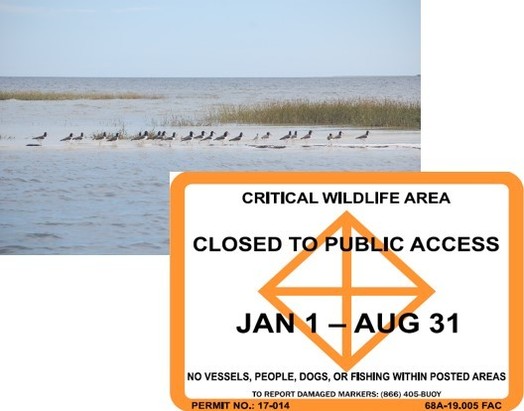
The featured project for this edition is the in-water
posting of the FWC’s new Critical Wildlife Areas. CWAs are discrete areas that
are posted as closed to public access in order to protect concentrations of
vulnerable wildlife from human disturbance. Closure periods and buffer
distances are designed to provide wildlife at each location with the space
needed to successfully roost, feed, nest, and
rear young. CWAs are established by the FWC, with landowner concurrence, under
Florida Administrative Code. After the FWC’s ambitious effort in 2016 to
establish new CWAs, there are now 32 CWAs throughout Florida.
Currently, FWC staff are completing the permitting and
contracting phase of this project to install in-water signs at 14 of the new CWAs.
These “closed to public access” markers are enforceable by the FWC and local
law enforcement, and they will buffer wildlife from human-related disturbances.
Buffers at CWAs typically range from 50 – 300 feet from the shoreline. Some
sites are closed to public access year-round, while others are closed
seasonally. Popular activities like wildlife viewing, photography and fishing
will continue to be enjoyed, but at a distance that will allow wildlife to
rest, forage and nest productively.
|
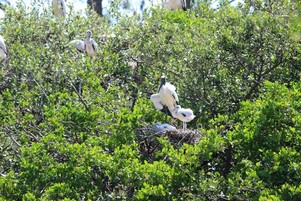 |
|
Fifteen of the new or re-established
CWAs are sandbars or spoil islands that support large concentrations of
breeding and roosting wading birds and shorebirds. For example, Flag Island CWA
in Franklin County supports an estimated 450 breeding pairs of birds
representing nine different species, including state-listed black skimmers, least
terns, and American oystercatchers.
|
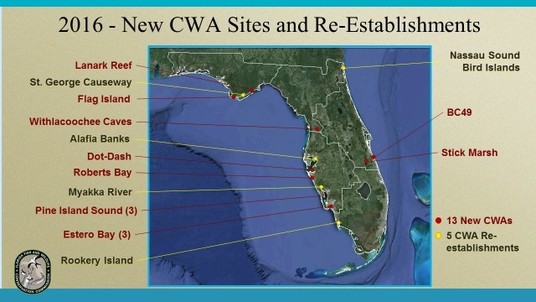
Critical Wildlife Areas are not only for birds. Among the newly established sites is Withlacoochee Caves CWA, which includes 6 caves in the Withlacoochee State Forest. This site provides breeding and wintering habitat for bats such as the tricolored bat and southeastern myotis. In Broward County, Deerfield Island Park CWA hosts one of the last populations of gopher tortoises within the county.
Posting CWA buffers is coordinated by FWC staff with the assistance of key partners. The FWC and partners also monitor sites and conduct habitat management activities, such as removal of exotic plants and predator control. Protection efforts are coordinated with the landowner, FWC law enforcement officers, local governments and other agencies and organizations, as appropriate.
For additional information or questions about CWAs, contact the CWA coordinator at CWAComments@MyFWC.com. To learn more about Florida’s CWAs, please visit www.MyFWC.com/CWA.

The American horseshoe
crab is a common sight on Florida's beaches, especially during the spring and fall.
Horseshoe crabs are known for their large nesting aggregations, or groups, on
beaches all along the east coast of the United States. In Florida, horseshoe
crabs can nest year-round, with peak spawning occurring in the spring and
fall. When mating, the smaller male crab attaches himself to the top
of the larger female’s shell by using his specialized front claws, and together
they crawl to the beach. The attached pair bury themselves in the sand and the
male fertilizes the eggs as the female lays them in the nest. Some males
(called satellite males) do not attach to females but still have success in
fertilizing the female's eggs as they crowd around the attached pair. Most
of this nesting activity takes place during high tides around the time
of a new or full moon.
What you can do:
- If you observe horseshoe crabs spawning in Florida (two or more connected
together), please report this information to the FWC by filling out the online
survey where you can input the
information directly, email horseshoe@MyFWC.com, or call 866-252-9326. These observations
will help biologists gain a better understanding of where and when
horseshoe crabs are spawning in Florida.
- Consider
joining the Florida
Horseshoe Crab Watch citizen science program, in which trained volunteers
assist biologists in surveying, tagging and resighting Florida’s nesting
horseshoe crab populations utilizing a standardized scientific protocol.
- If
you see a horseshoe crab upside-down, you can help it out by picking it up by
both sides of its shell, turning it over and releasing it in the water. Usually
they can turn themselves over with their telson (tail), but sometimes they get
overturned by high wave action during spawning and may not be able to right
themselves, which can lead to death. Never pick up a horseshoe crab by its
tail, as it can harm the animal.
-
If
you observe inappropriate harvest of horseshoe crabs (use of gear other than by
hand or gig or harvest of more than 100 horseshoe crabs in one day), report it
to the FWC’s Wildlife Alert line at 888-404-FWCC (3922) or text Tip@MyFWC.com.
- When
considering options for shoreline stabilization for your property, avoid
seawalls and other types of development that can disrupt the horseshoe crab's
reproductive activities.
|
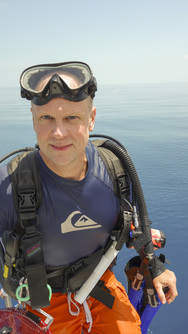
-
What is your title? Biological Scientist IV (technically) but
I often tell non-agency folks that I’m the Marine/Estuarine Habitat Coordinator
for the Indian River Lagoon as it’s more descriptive.
-
What organization do you work for? FWC, Division
of Habitat and Species Conservation, Aquatic Habitat Conservation and Restoration
Section, Marine/Estuarine Subsection (MESS!)
-
What type of work do you do? I focus on the conservation and restoration
of aquatic habitats including saltmarshes, mangroves, seagrasses, tidal
riverine wetlands, oysters and coral reefs. This involves partnering with
numerous entities, representing the agency on regional matters affecting
species and habitats, and often securing grant funds and managing contracts to
complete projects to improve or create habitats.
-
What project(s) have you recently been working
on? As a result of a long
partnership with numerous agencies and other entities including the National
Oceanic and Atmospheric Association’s Coastal
Habitat grant program, we recently restored 5 acres of saltmarsh on FWC
property in New Smyrna Beach. The site is high profile and attracts numerous
visitors, especially to the non-profit
partner (Marine Discovery Center) conducting various programs on the site. As
part of the project, we created a shoreline stabilization demonstration area
for waterfront landowners to learn about alternatives for securing erosion,
including the use of Living
Shorelines concepts. Plants grown in the marsh are used for regional
restoration projects. Working in south Florida, our agency is strategically focused
on the Everglades. One aspect of this large-scale restoration is developing performance
measures and monitoring key features which define success. Through a
partnership with Florida Atlantic University, we are monitoring the effects of
Everglades restoration on coral stress, as it relates to freshwater releases
through St. Lucie Inlet. This project
has become increasingly important because of a recent coral disease outbreak
along the Florida Reef Tract.
-
How does your work relate to the CWCI? The work accomplished by MESS relates
strongly to the CWCI mission. Both programs focus on coastal species and
habitats. We partner to conserve them as much as possible, often acting as
subject matter experts to inform coastal issues and projects. The MESS program also works
especially to improve the habitats, through restoration or enhancement, which
benefits the species.
-
How long have you been working in the coastal
environment, and what are some lessons you have learned? I’ve worked in
coastal east-central Florida for more than 25 years,
including graduate school at Florida Institute of Technology in Melbourne. I’ve
learned that there are many things we know about the coastal zone (as proved by
my office bursting with reports) but have enjoyed discovering new things that
make me wonder how much we truly understand about these dynamic systems. They
are surprisingly resilient in some ways and surprisingly vulnerable in others.
I’ve also embraced the need to continually update my personal knowledge of
species and habitats, often learning from the experiences of colleagues.
Frankly, most of what I know was forced learning on the job. School prepared me with a
foundation for constant learning and application. The job can get frustrating at times, but
something will grab my attention that I’ve never learned before and I’m
transported back to wonderland.
-
What do you think is the greatest threat to
coastal ecosystems, and what action(s) should be undertaken to address it?
Over-development is the greatest threat to
our coasts. The passage of major storms is a poignant reminder that these
habitats are dynamic, wild and fragile and that we cannot truly control or tame
them. We must be realistic about our ability to maintain infrastructure while
also being cognizant of the many great benefits provided by green space and
natural areas in the coastal zone. Conservation and restoration of coastal habitats not only makes sense
for the species we hope to protect, they make sense on myriad levels including economically.
-
What is your favorite coastal animal, and
why? I’m a fish guy by trade and experience. I’ve always been fascinated by
them, and east-central Florida is a fish lovers paradise with nearly 800
species to study. One fish in particular caught my attention while working my
first job in the field: the orange spotted
goby (Nes longus). Each one lives
commensally in a burrow maintained by a snapping shrimp. The fish perches in
front of the burrow and warns the shrimp of danger using fin movements … guard
duty in exchange for free housing … inter-phyla cohabitation. My mentor and I
discovered the first recorded specimen in Indian River Lagoon years ago and I
still recall vividly the fascinating moment it happened. This story reminds me that
partnering done right leads to mutual benefit.
-
Do you have a message you would like to share
with readers of this newsletter? Coastal areas provide numerous benefits to
us, some of which are behind the scenes that we might take for granted. They
filter water to our aquifers, provide habitat for recreationally and
commercially important species, house rare and imperiled species, cycle
nutrients to improve our water quality, produce oxygen for us to breathe,
and take the brunt of storms while protecting private property. There’s one
additional benefit that I hope we won’t forget: they provide peace and solace
and an opportunity for reflection, recharge, and awe … if
we’ll carve out time to allow them to inspire us. I’ve rarely been moved to peace, tranquility,
and contentment by the manmade, but perhaps that’s just me.
NOTE: Jeff just received the
prestigious 2017 Melissa Laser Fish Habitat Conservation Award from the
Atlantic Coastal Fish Habitat Partnership for working tirelessly on estuarine
habitat restoration and conservation for the FWC for over a decade and finding innovative ways to initiate fish habitat
projects.
|
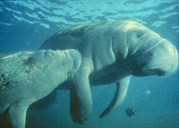
This fall’s
Critter of the Quarter is the Florida manatee (Trichechus manatus latirostris), which begins migrating in November
to warm water areas that are necessary to survive the colder weather of the
winter. In warmer months some Florida manatees may travel outside of peninsular
Florida, however Florida is the northern end of its winter range. A system of
warm-water refuges, including natural springs, power-plant outflows, and passive
thermal basins provide shelter in cold weather.
Adults
are typically 9-10 feet long and weigh around 1,100 pounds. They have two flippers
that they use to help steer themselves through the water and a paddle-shaped
tail that they use to propel themselves forward. They are mammals, so they have
fine hairs all over their body and breathe air. They are in the family Sirenian,
which includes other species of manatees, the dugong and the extinct Stellar’s
sea cow. Their closest relatives on land
are the elephant and the hyrax. Manatees are herbivores and eat over 60 species
of freshwater and marine vegetation, although seagrass is a dietary staple. They
reach sexual maturity at 3 to 7 years, and their gestation is approximately 13
months. A calf may stay with its mother for up to two years or more.
Threats
to manatees include watercraft-related mortality and injuries, entanglement, and
long-term loss of warm-water habitats. Human-related mortality and rescues
underscore the conservation reliance of the species—meaning that threats cannot
be eliminated, but only managed. Sound conservation practices and strong public
stewardship are needed to sustain the species and reduce human-related threats.
Your actions matter! When on the water, looking out for manatees, complying
with posted speed zones, and properly disposing of fishing line and other waste
are important ways to make a difference and could even save a life.
|
Audubon Christmas Bird
Count – Sign up in November to help with a bird count that runs
December 14 through January 5. Audubon and other organizations use data
collected in this long-running wildlife census to assess the health of bird
populations and to help guide conservation action.
Florida
Horseshoe Crab Watch citizen science program – Assist biologists in surveying, tagging and resighting Florida’s
nesting horseshoe crab populations utilizing a standardized scientific
protocol. For more information, contact tiffany.black@myfwc.com.
Monofilament Recovery and Recycling Program
– Volunteer to empty a monofilament recycling bin at regular intervals at a
location near you, or help keep fishing line and marine debris out of the
environment in other ways. For more information, contact Marine@myfwc.com.
Red Tide Offshore Monitoring Program – A volunteer program to assist the researchers
who study Karenia brevis, the
organism that causes Florida red tide. Citizen volunteers expand the spatial
coverage of FWRI's monitoring program by collecting water samples from routine
collection points and sites reported for suspected harmful algal blooms (HABs).
For more information, contact RTOMP_coordinator@MyFWC.com.
Tampa Bay Watch Restoration – A variety of hands-on habitat
restoration projects such as oyster dome construction, oyster shell bar
installation, salt marsh plantings and coastal cleanups to help the bay recover
from its devastating environmental problems. For more information, contact rarndt@tampabaywatch.org.
Mohamed bin Zayed Species Conservation Fund
— Grants of up to $25,000 will be awarded in support of plant, animal, and
fungi species conservation efforts for endangered species, without
discrimination on the basis of region or selected species. The deadline is October 31, 2017.
NOAA Marine Debris Program Marine Debris
Removal grant — Provides
funding to support projects that will create long-term, quantifiable ecological
habitat improvements for NOAA trust resources through on-the-ground marine
debris removal activities, with priority for those targeting derelict fishing
gear and other medium- and large-scale debris. The deadline is November 1, 2017.
The Conservation Alliance Grants — Program seeks to protect threatened
wild places throughout North America for their habitat and recreational values.
Grant requests of up to $50,000 are accepted from registered 501(c)(3)
organizations. The deadline for nomination is November 1, 2017.
The Lawrence Foundation Grants — Foundation makes grants to US-based
qualified charitable organizations for projects that support environmental, education,
human services and other causes. The proposal deadline is November 1, 2017.
The Max and Victoria Dreyfus Foundation
Grants — Grants are
considered for non-profit organizations located within the United States for
programs and projects including environmental and wildlife protection
activities up to $20,000. The deadline is
November 10, 2017.
Captain Planet Foundation -- Educators, both K-12 classroom and
informal, who are interested in receiving support for students to design and
implement hands-on environmental solutions are eligible for project funding.
Deadline is January 15, 2017.
Alcoa Foundation Grant Program —
Sustainability is a major focus promoting 1) the prevention of and resilience
to climate change and 2) the restoration and preservation of biodiversity.
Grants are awarded on a rolling basis.
BoatUS Foundation Grassroots Grants Program – Povides grants up to $10,000 to nonprofit organizations, boating
clubs and student groups for projects that promote safe and/or clean boating. Applications
are accepted year round.
David & Lucile Packard Foundation — Grants are made for charitable,
educational, or scientific purposes, primarily from tax-exempt charitable
organizations. Grants fall under several categories including climate, ocean,
land, science, and conservation.
George & Miriam Martin Foundation
Grants — The focus of the foundation is river and watershed
conservation. Grants range from $1,000 - $200,000. There are no deadlines.
Rockefeller Family Fund — Grant
making currently has an environment program focus on the challenges of climate
change with an emphasis on public education. Letters of inquiry may be
submitted at any time.
Surdna Foundation Grantmaking — Grant making to nonprofit
organizations in the priority areas of Sustainable Environments, Strong Local
Economies and Thriving Cultures. Letters of inquiry may be submitted at any
time.
Waitt Foundation Rapid Ocean Conservation
(ROC) Grants — This opportunity provides small grants with a quick
turnaround time for solutions to emerging conservation issues. The funding
cycle is open to new applications. Proposals are reviewed monthly on a rolling
basis, although some applications take additional time to evaluate.
Wells Fargo Environmental Grant Program
— Environmental grant program focuses on addressing local environmental
priorities in communities and providing support that fosters innovation to help
accelerate a “green” economy. One letter of inquiry per year per organization
is accepted.
|